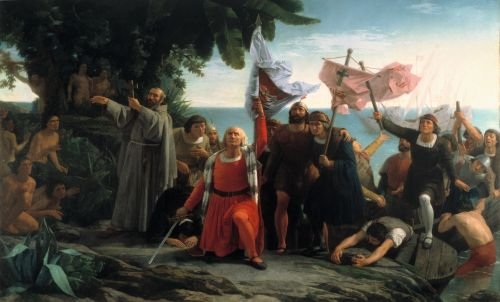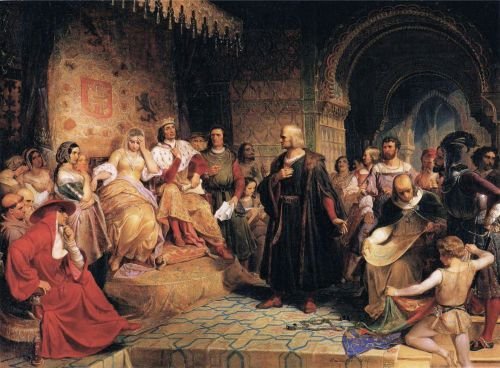Discovery of America: What is it, Characteristics and Meanings
Discovery of America
The discovery of America is known to the historical moment that occurred on October 12, 1492 , when Europeans first arrived on the American continent on an expedition commanded by Christopher Columbus. This expedition, originally destined for India, was made in the name of the Spanish crown.
Despite being marked by chance, the discovery of America had a fundamental importance for history, since the continent was no longer isolated from Afroeurasia , the world map was unveiled and the globalization process began, although in a very incipient.
America was not then an uninhabited continent, but there existed from nomadic tribes to great civilizations such as the Mayan , the Mexica and the Inca . The previous presence of all these cultures has been motivation to question to what extent the expression discovery of America does justice to history.
For this reason, depending on the country and the ideological system in force, the commemorative day of the discovery is usually also called the day of the race, the meeting of two worlds, the day of diversity, the day of decolonization, the day of respect and cultural diversity, the day of Las Americas, Columbus Day, Day of Cultures, Day of Cultural Identity and Diversity and Day of Indigenous Resistance.
The Arrival of Christopher Columbus in America
Christopher Columbus was a navigator of Genoese origin. Convinced that the Earth was spherical, Columbus set out to show that India could be reached more quickly if, instead of skirting the continental coasts, he went around the world. At the same time, this endeavor would prove to people the roundness of the Earth.
The Genoese sought funding from the Portuguese court, known for its interest in maritime explorations. However, Portugal rejected his proposal.
Columbus then turned to the Spanish crown, which he demanded all sorts of privileges in compensation. Spain, represented then by Isabel la Católica and Fernando II of Aragon, also declined. However, when they learned that Columbus was heading to France with the same intention, they reconsidered the case and approved the expedition.
The Spanish crown gave Columbus two caravels and he, for his part, rented a third. The caravels received the names of Pinta, Niña and Santa María .
Supposedly, a sailor aboard the Pinta, named Rodrigo de Triana (Juan Rodríguez Bermejo), spotted land and alerted the crew, thus concluding a voyage of more than two months through the Atlantic Ocean.
However, although it is thus collected in some sources, Colón claimed to have seen some lights for himself the night before, an argument with which he refused to give the agreed reward to Triana.
Columbus arrived in America on October 12, 1492, on the shores of San Salvador , where he found copper-colored settlers. He was convinced, therefore, that he had reached the India that he sought so much, for which he gave the place the name of the West Indies and its people the name of " Indians ."
 Dioscorus Teófilo Puebla: Landing of Columbus . 1862. Oil on canvas. Prado Museum, Madrid.
Dioscorus Teófilo Puebla: Landing of Columbus . 1862. Oil on canvas. Prado Museum, Madrid.
Christopher Columbus travels
Columbus made a total of four trips to explore the region. Those trips were the following:
- First trip: carried out in 1492. Explore the island of San Salvador.
- Second trip: carried out between 1493 and 1496. Explore the Antilles.
- Third trip: occurred between 1498 and 1500. Explore the island of Trinidad, the Gulf of Paria and the island of Margarita, the latter two located in Venezuela. In this country he reaches Macuro, the first continental territory that Columbus knows.
- Fourth trip: undertaken between 1502 and 1504. Explore the coast of Nicaragua, Honduras, Panama and Costa Rica.
Causes of the discovery of America
The discovery of America was the result of a set of historical circumstances and, likewise, it was a turning point in the history of mankind. Let's see why.
- Development of naval technology, as well as progress in the cartographic and scientific field.
- Fall of the Byzantine Empire into the hands of the Ottoman Empire, which blocked or hindered trade between the West and the East.
- Need for new trade routes.
- Need to find natural resources for exploitation.
- Need for expansion of Western trade to the Far East (China and Japan).
Consequences of the discovery of America
- Unveiling of the world map.
- Conquest and colonization of the American continent by Europeans.
- Submission of the Amerindian populations to the Western military, political, religious and cultural order.
- Business expansion of Europe.
- Settlement of the hegemony of the conquering kingdoms: Spain, Portugal, England, France and Holland.
- Development of the transatlantic economy.
- Beginning of the globalization process, that is, the integration of the whole world in a universal historical narrative.
 Emanuel Gottlieb Leutze: Columbus before Queen Elizabeth the Catholic .
Emanuel Gottlieb Leutze: Columbus before Queen Elizabeth the Catholic .
- Update date: March 9, 2021.
Recommended Contents
- Annexes (What they are, Characteristics and Meanings)
- Discovery of America
- Equipment: (What they are, Characteristics and Meanings)
- Triple Alliance (What they are, Characteristics and Meanings)
- Types of culture
- Types of science
- What are Annexes
- What are Castes of New Spain?
- What are Social Movements
- What is Equipment
- What is Fire
- What is Meme
- What is Triple Alliance
- What is the Conquest of America
- What is the right to life
.